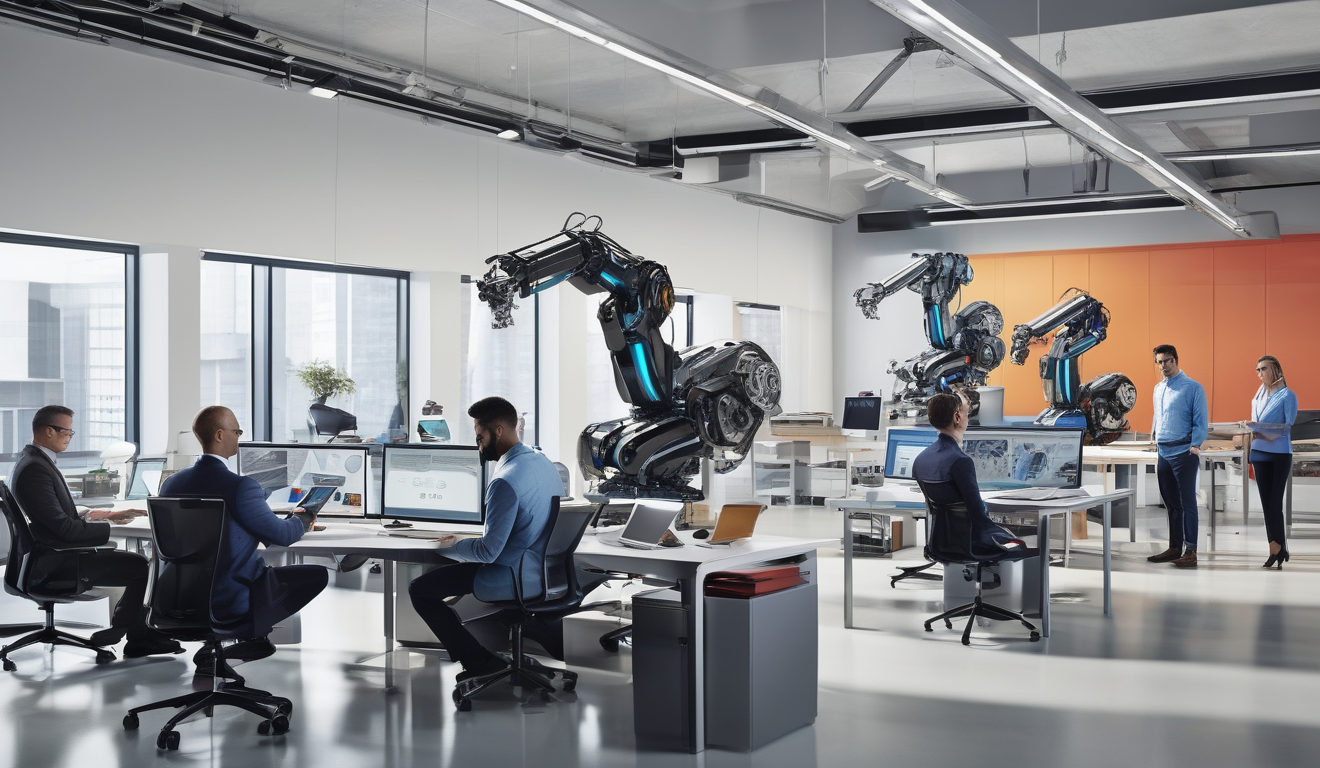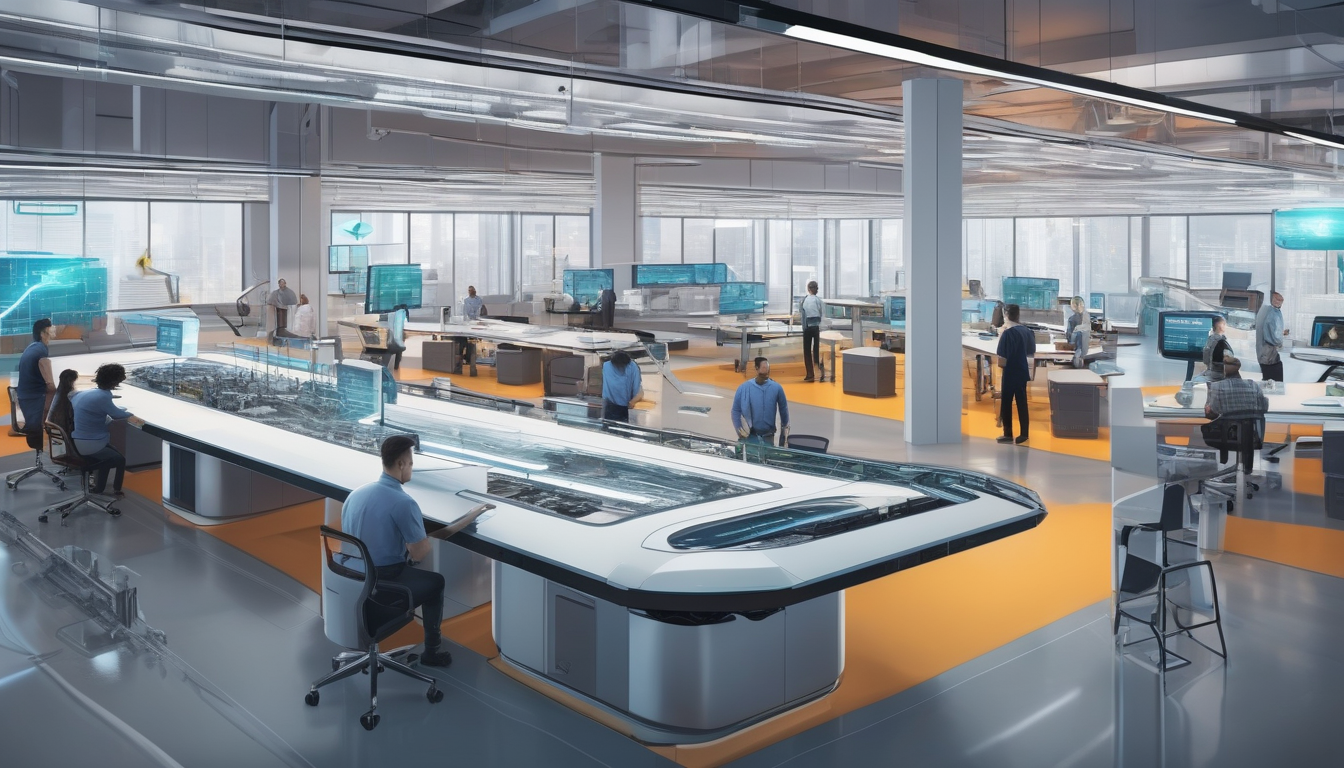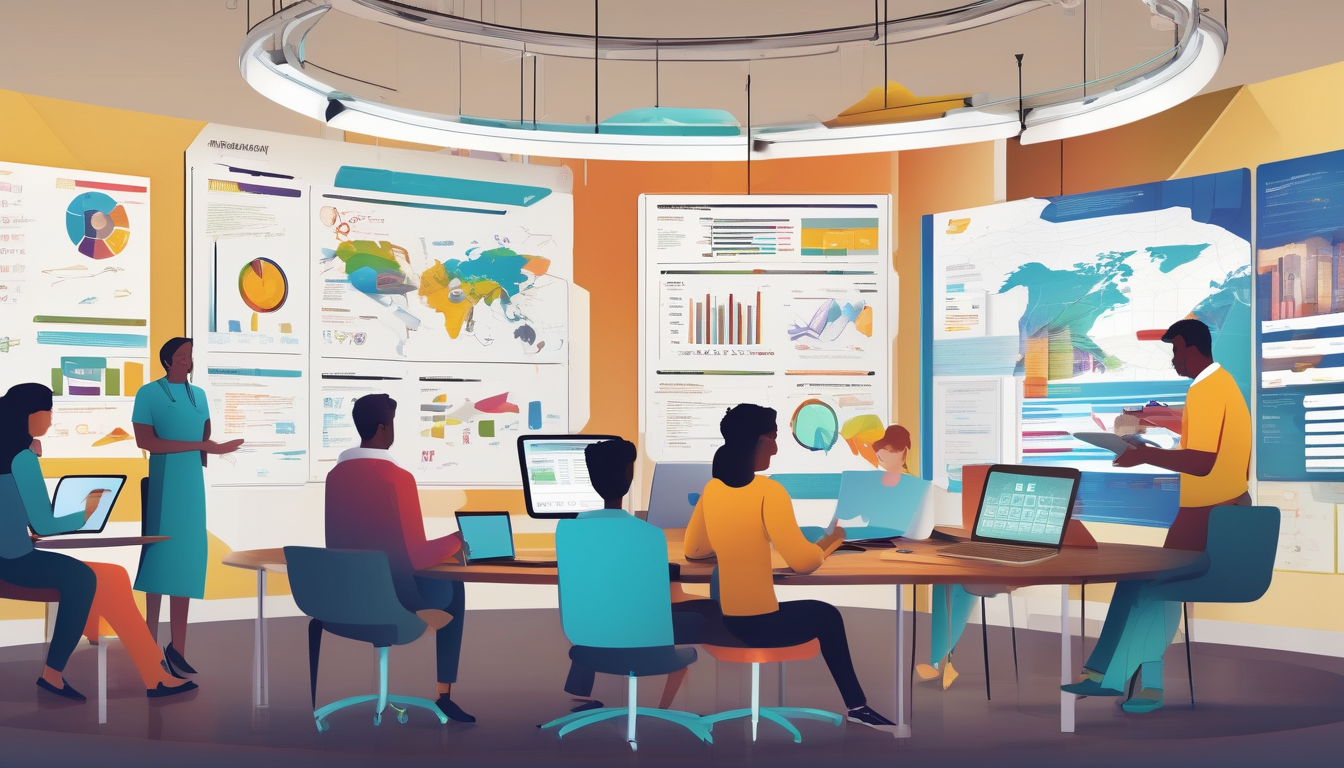How Automation Is Reshaping the Job Market

Automation is no longer just a buzzword; it’s a powerful force that is transforming the job market before our very eyes. Imagine waking up one day to find that your job has been taken over by a machine or software. It sounds alarming, right? But here’s the twist: while automation does pose challenges, it also opens up a treasure trove of opportunities. Understanding this dual nature of automation is essential for both employees and employers as they navigate through this rapidly changing landscape.
As we dive deeper into the world of automation, it’s crucial to recognize that it’s not just about robots replacing humans. Automation technologies are being integrated into various industries—from manufacturing to healthcare—leading to significant shifts in job roles and responsibilities. For instance, in the manufacturing sector, robots are taking over repetitive tasks, allowing human workers to focus on more complex and creative responsibilities. This shift is reshaping not just what jobs are available, but also how we define work itself.
Now, let’s talk about the elephant in the room: job displacement. Yes, automation may displace certain jobs, but it’s not the end of the story. New opportunities are emerging in fields like data analysis, AI development, and cybersecurity. The key is to stay informed about how the job landscape is evolving. What skills are in demand? How can workers position themselves to thrive in this new environment? It’s a bit like surfing; you have to ride the wave of change instead of getting wiped out by it.
The balance between job displacement and job creation is a critical aspect of automation. According to recent studies, it’s estimated that while automation may eliminate around 75 million jobs by 2025, it could also create 133 million new roles. This statistic highlights the importance of adapting to changes rather than fearing them. The net effect on employment can be positive if we are willing to embrace new opportunities.
Some industries are more susceptible to automation than others. For example:
- Manufacturing
- Retail
- Transportation
These sectors are experiencing significant changes, which can be daunting for workers. However, understanding these shifts can help them prepare for what’s next.
As automation evolves, new job categories are being created. Roles such as robotics technicians, data scientists, and AI trainers are just the tip of the iceberg. These positions are not only essential for maintaining automated systems but also for driving innovation in the workplace.
To thrive in an automated job market, workers need to adapt. Skills like critical thinking, creativity, and emotional intelligence are becoming increasingly valuable. The ability to work alongside machines and leverage technology will set successful candidates apart.
Education and training programs play a vital role in preparing the workforce for an automated future. Institutions are adapting their curricula to meet these new demands, ensuring that students are equipped with the skills needed for tomorrow’s jobs. This proactive approach is essential for bridging the gap between education and employment.
Reskilling and upskilling are essential for workers transitioning to new roles. Various initiatives and programs are aimed at helping employees adapt to changes in the job market. For instance, online courses and vocational training can provide workers with the tools they need to succeed in emerging fields.
Finally, collaboration between industry leaders and educational institutions can enhance workforce readiness. Successful partnerships can lead to tailored training programs that meet the specific needs of employers, ultimately benefiting both workers and businesses.

The Rise of Automation
Automation technologies are revolutionizing the way we work, and it’s happening faster than you might think! From manufacturing to service industries, robots and software are stepping in to take over tasks that were once the sole domain of humans. But what does this mean for us? Understanding the impact of automation is crucial for both employers and employees as we navigate this new landscape.
As companies strive for efficiency and cost-effectiveness, the adoption of automation is becoming more prevalent. Think about it: machines can work around the clock without breaks, and they don’t need health insurance or vacation time! This shift is not just a trend; it’s reshaping job roles and responsibilities in profound ways. For instance, in the manufacturing sector, assembly lines are becoming increasingly automated, which allows for higher production rates but also means fewer assembly line jobs for humans.
However, it’s not all doom and gloom. While some jobs are disappearing, new opportunities are emerging in fields that didn’t even exist a decade ago. For example, positions like robotic process automation (RPA) developers and data analysts are in high demand as businesses seek to leverage technology for better decision-making. This evolution presents a unique opportunity for workers willing to adapt and learn new skills.
Moreover, the rise of automation is prompting a shift in the types of skills that are valued in the job market. Employers are increasingly looking for candidates who possess a blend of technical skills and soft skills, such as problem-solving and creativity. In fact, a recent study highlighted that over 60% of jobs created in the next decade will require these competencies. To put it simply, the future of work is not just about machines; it’s about how we can work alongside them to create a more efficient and innovative workplace.
In conclusion, the rise of automation is a double-edged sword. While it brings challenges, it also opens doors to new possibilities. As we embrace this change, it’s essential for both workers and employers to stay informed and proactive in adapting to the evolving job market. After all, the future is not something we enter; it’s something we create together!

Impact on Employment Opportunities
As we dive into the world of automation, it’s essential to recognize that while certain jobs may vanish, a plethora of new opportunities are sprouting up like wildflowers in spring. The job market is not simply shrinking; it’s transforming. This metamorphosis is driven by technological advancements that are reshaping traditional roles and creating entirely new categories of employment. For instance, positions in fields such as data analysis, artificial intelligence, and cybersecurity are gaining traction, reflecting the growing demand for tech-savvy professionals.
But what does this mean for the average worker? Well, it’s a double-edged sword. On one hand, you have the risk of job displacement, particularly in industries where repetitive tasks are commonplace. Think about manufacturing or basic administrative roles—these are often the first to feel the heat of automation. On the other hand, this disruption opens doors to exciting new careers that didn’t even exist a decade ago. The key lies in understanding how to navigate this shifting landscape.
To illustrate this change, let’s take a look at a few emerging job categories:
- Data Analysts: As businesses accumulate vast amounts of data, professionals who can interpret this information are in high demand.
- Robotics Technicians: With the rise of automated machines, technicians who can maintain and repair these systems are increasingly sought after.
- AI Specialists: Experts who can develop and manage artificial intelligence systems are becoming crucial as companies look to integrate these technologies into their operations.
Moreover, many of these new roles require a different set of skills than what was traditionally valued. Employers are now looking for individuals who are not only technically proficient but also possess soft skills like creativity, problem-solving, and emotional intelligence. It’s a brave new world out there, and adaptability is the name of the game.
In summary, while automation may pose challenges, it also presents a wealth of opportunities for those willing to embrace change. By staying informed and continuously developing new skills, workers can position themselves at the forefront of this evolving job market, ready to seize the opportunities that await.
Job Displacement vs. Job Creation
The debate surrounding job displacement versus job creation in the age of automation is both complex and crucial. As we witness machines and algorithms taking over various tasks, it’s natural to feel a sense of unease about the future of work. However, it’s essential to look beyond the surface and understand that while some jobs may vanish, new opportunities are also emerging. Think of it like a game of chess; every time a piece is taken off the board, a new strategy must be devised.
Statistics show that automation is set to displace approximately 25% of jobs in the next decade. But here’s the twist—it’s also projected to create around 15 million new jobs in fields that don’t even exist yet! This paradox highlights the dynamic nature of the job market. For instance, roles in data analysis, robotics maintenance, and AI ethics are just the tip of the iceberg when it comes to new opportunities. So, what does this mean for you?
To truly grasp the impact of automation, we must analyze the net effect on employment. A recent study revealed that while automation may lead to the loss of certain repetitive roles, it simultaneously fosters growth in sectors that require human creativity and emotional intelligence. For example, jobs in healthcare, education, and creative industries are becoming more vital as they cannot be easily automated. This shift emphasizes the need for workers to adapt and acquire new skills.
Moreover, industries such as manufacturing and retail are experiencing the most significant changes. According to recent data:
| Industry | Job Displacement (%) | Job Creation (%) |
|---|---|---|
| Manufacturing | 40% | 10% |
| Retail | 30% | 5% |
| Healthcare | 10% | 25% |
| Technology | 5% | 50% |
This table illustrates that while some industries face high displacement rates, others, particularly in technology and healthcare, are seeing substantial job creation. Therefore, the key takeaway is that while automation does pose challenges, it also opens doors to new possibilities. Embracing change and staying informed will be crucial for navigating this evolving landscape.
Industries Most Affected
The wave of automation is crashing into various sectors, and some industries are feeling the impact more than others. For instance, the manufacturing sector has been at the forefront of automation for decades. Robotics and AI have taken over repetitive tasks, increasing efficiency but also leading to significant job losses. Imagine a factory floor where machines work tirelessly, producing goods at lightning speed while human workers are left to find new roles elsewhere.
Another industry experiencing substantial changes is retail. With the rise of e-commerce, traditional retail jobs are evolving. Automated checkout systems and inventory management software are becoming the norm, allowing companies to cut costs and streamline operations. This shift raises the question: will there still be a place for human cashiers in the future, or will they become a thing of the past?
Additionally, the transportation sector is on the brink of transformation. Self-driving vehicles are not just a futuristic concept anymore; they are being tested and implemented in various capacities. This innovation could potentially displace millions of driving jobs, from truck drivers to taxi services. However, it also opens up new avenues for jobs in tech support, vehicle maintenance, and logistics planning.
Healthcare, while often seen as a human-centric field, is also not immune to automation. The integration of AI in diagnostics and patient management systems is changing the landscape. Although this technology enhances efficiency and accuracy, it also raises concerns about the future roles of healthcare professionals. Will doctors and nurses become more like overseers, managing automated systems rather than providing hands-on care?
To illustrate the impact across these sectors, consider the following table:
| Industry | Impact of Automation | Future Job Outlook |
|---|---|---|
| Manufacturing | Increased efficiency, job displacement | Shift towards tech roles |
| Retail | Automated checkouts, e-commerce growth | Decrease in traditional roles, rise in tech jobs |
| Transportation | Self-driving vehicles, logistics automation | Reduction in driving jobs, increase in tech support roles |
| Healthcare | AI diagnostics, patient management systems | More oversight roles, potential for new tech jobs |
As we can see, automation is reshaping the job market in profound ways. While some industries face challenges, others may emerge stronger, adapting to the new landscape. It’s a complex dance between displacement and opportunity, and understanding these shifts is crucial for anyone looking to navigate the future job market successfully.
New Job Categories Emerging
As automation continues to evolve, it’s not just about machines taking over traditional roles; it’s about the birth of entirely new job categories that didn’t exist a decade ago. Imagine a world where jobs like robotic process automation (RPA) developer or AI ethicist are not only real but in high demand. These roles are emerging as businesses integrate advanced technologies into their operations, creating a fascinating landscape for job seekers.
For instance, the rise of data analysis has paved the way for roles such as data scientists and data engineers. Companies are now seeking professionals who can sift through mountains of data to extract valuable insights, helping them make informed decisions. This shift means that workers need to be equipped with skills in data interpretation and statistical analysis, areas that are becoming increasingly crucial in the job market.
Moreover, the growth of e-commerce has led to the emergence of new positions like e-commerce specialists and digital marketing strategists. As more businesses move online, they require experts who can navigate the complexities of online sales and digital branding. This transition is not just a trend; it’s a fundamental change in how businesses operate, and those who adapt will find themselves at the forefront of this digital revolution.
Additionally, the healthcare sector is also witnessing new job categories due to automation. Roles such as telehealth coordinators and health informatics specialists are becoming vital as technology enhances patient care and data management. The importance of these positions cannot be overstated, as they bridge the gap between technology and healthcare, ensuring that patients receive the best possible care in an increasingly automated world.
In summary, the job market is transforming, and with it, new opportunities are emerging. To stay ahead, workers must be willing to learn and adapt. The future will belong to those who are not just aware of these changes but actively seek to embrace them. The key takeaway? Embrace the change, and you’ll not only survive but thrive in this exciting new job landscape.
Skills for the Future
As we navigate through this era of rapid technological advancement, it’s essential to recognize that are not just an add-on; they are a necessity. The job market is evolving, and so should our skill sets. With automation taking center stage, workers must adapt to remain relevant. Imagine trying to sail a ship without knowing how to navigate; that’s how it feels for those unprepared for the future job landscape.
In this new world, certain skills are becoming increasingly valuable. Critical thinking and problem-solving are at the top of the list. Employers are seeking individuals who can analyze situations, think outside the box, and find innovative solutions to complex problems. For instance, when faced with a challenge in a production line due to automation, a critical thinker can devise a workaround that enhances efficiency without compromising quality.
Moreover, digital literacy is no longer optional. With technology embedded in nearly every job, being tech-savvy is crucial. This includes not just knowing how to use software but also understanding data analytics, coding basics, and digital communication tools. Workers who can navigate these digital landscapes will undoubtedly have a competitive edge.
Another vital skill is emotional intelligence. As automation takes over repetitive tasks, the human touch becomes more valuable. Workers who can empathize, communicate effectively, and collaborate with others will thrive. In fact, a recent study showed that teams with high emotional intelligence perform significantly better than those that lack it.
To summarize, the skills that will define the future job market include:
- Critical Thinking
- Problem Solving
- Digital Literacy
- Emotional Intelligence
In conclusion, as we prepare for an automated future, investing in these skills will not only enhance individual employability but also contribute to a more adaptable and resilient workforce. The question is, are you ready to embrace this change and equip yourself for the challenges ahead?

The Role of Education and Training
In today’s rapidly evolving job market, the significance of education and training cannot be overstated. As automation continues to reshape industries, the need for a workforce that is both skilled and adaptable has never been greater. Employers are looking for individuals who can navigate complex technologies and contribute to innovative solutions. This shift necessitates a reevaluation of traditional educational pathways and a commitment to lifelong learning.
Many educational institutions are stepping up to the plate, redesigning their curricula to align with the needs of an automated future. For example, programs that focus on STEM (Science, Technology, Engineering, and Mathematics) are gaining traction, as these fields are at the forefront of technological advancement. Moreover, institutions are increasingly incorporating hands-on training and real-world projects into their coursework, allowing students to gain practical experience that is invaluable in the job market.
Additionally, reskilling and upskilling initiatives are becoming essential for workers who find their roles changing due to automation. Many companies are now investing in training programs that help employees transition to new positions or enhance their existing skills. These programs often focus on areas such as data analysis, machine learning, and digital marketing, which are in high demand. The table below highlights some key initiatives aimed at bridging the skills gap:
| Initiative | Description | Target Audience |
|---|---|---|
| Tech Bootcamps | Intensive training programs focusing on coding and software development. | Career changers and recent graduates. |
| Online Courses | Flexible learning options covering various skills, from AI to project management. | Working professionals seeking to upskill. |
| Corporate Training | Customized training programs developed in collaboration with industry leaders. | Current employees in need of reskilling. |
Furthermore, collaboration between industry and educational institutions is crucial for developing relevant training programs. By working together, they can ensure that the curriculum not only meets current demands but also anticipates future trends. This synergy creates a workforce that is not only prepared for today’s challenges but is also resilient enough to adapt to whatever comes next. In this way, education and training serve as the bedrock of a thriving, automated economy.
Reskilling and Upskilling Initiatives
As we navigate the shifting landscape of the job market, reskilling and upskilling have emerged as essential strategies for workers aiming to stay relevant and competitive. These initiatives are not just buzzwords; they represent a proactive approach to adapting to the rapid changes brought about by automation. Think of it as a survival kit for the modern workplace—equipping yourself with the right tools to thrive in an evolving environment.
Many organizations are recognizing the urgent need to invest in their workforce. Companies are rolling out programs designed to help employees learn new skills or enhance existing ones. This is crucial because, as automation continues to streamline operations, the demand for workers with specialized skills is on the rise. For instance, roles in data analysis, digital marketing, and software development are becoming increasingly sought after. In fact, a recent survey showed that 74% of employers plan to upskill their employees to meet future demands.
Here are some key initiatives that are gaining traction:
- Online Learning Platforms: Websites like Coursera and Udacity offer courses tailored to industry needs, allowing workers to learn at their own pace.
- Corporate Training Programs: Many companies are partnering with educational institutions to provide tailored training sessions that align with their specific operational needs.
- Government Grants: Various governments are offering financial assistance to both individuals and companies to promote workforce development.
Moreover, the collaboration between industry and educational institutions is proving to be a game changer. By aligning curricula with real-world skills, these partnerships ensure that students are job-ready upon graduation. This synergy not only enhances the learning experience but also creates a pipeline of talent that meets the evolving demands of the job market.
In conclusion, reskilling and upskilling initiatives are vital for individuals and organizations alike. They not only help mitigate the risks associated with job displacement due to automation but also empower workers to seize new opportunities that arise in the wake of technological advancements. As we look to the future, it’s clear that those who embrace continuous learning will be the ones who thrive in an automated world.
Collaboration Between Industry and Education
The partnership between industry and education is becoming increasingly vital in today’s fast-paced world. As automation continues to reshape the job market, it’s essential for educational institutions to align their curricula with the skills demanded by employers. This collaboration ensures that students are not only learning theoretical concepts but are also equipped with practical skills that are directly applicable in the workplace.
One of the most significant benefits of this collaboration is the ability to provide students with real-world experience. For example, internships and co-op programs allow students to work alongside professionals, gaining insights into industry practices while enhancing their resumes. These initiatives create a win-win situation: students gain valuable experience, and employers get to evaluate potential hires before making long-term commitments.
Moreover, industry leaders can offer feedback on educational programs, helping institutions to refine their teaching methods and course content. This ongoing dialogue ensures that students are learning the latest technologies and methodologies relevant to their fields. In fact, many schools have begun to incorporate hands-on projects and case studies into their curricula, simulating real-world challenges that students will face after graduation.
To illustrate the impact of these partnerships, consider the following table showcasing successful collaborations:
| Industry Partner | Educational Institution | Program Type | Outcome |
|---|---|---|---|
| TechCorp | State University | Internship Program | 70% of interns offered full-time positions |
| Health Inc. | Community College | Training Workshops | Increased job placement by 40% |
| AutoWorks | Technical Institute | Curriculum Development | Graduates more job-ready |
In conclusion, the collaboration between industry and education is not just a trend; it’s a necessity. As the landscape of work evolves, so must the training and preparation of future workers. By fostering strong partnerships, we can ensure that the workforce is ready to meet the challenges of an automated future, leading to a more robust economy and a more skilled labor pool.
Frequently Asked Questions
- What is the primary impact of automation on the job market?
Automation is reshaping the job market by displacing certain roles while simultaneously creating new opportunities in emerging fields. It’s like a double-edged sword, cutting away some jobs but also carving out new paths for employment.
- Which industries are most affected by automation?
Industries such as manufacturing, retail, and transportation are experiencing the most significant changes due to automation. Think of it as a wave sweeping through these sectors, altering job roles and responsibilities in profound ways.
- What skills will be in demand in the automated job market?
Skills like data analysis, programming, and digital literacy are becoming increasingly valuable. It’s essential to adapt and learn, much like upgrading your smartphone to keep up with the latest apps and features.
- How can workers prepare for the changes brought by automation?
Workers can prepare by engaging in reskilling and upskilling initiatives, which help them transition to new roles. This is akin to learning to ride a bike again after being off it for years—it’s all about getting back in the saddle with new skills!
- What role does education play in adapting to automation?
Education is crucial as institutions are updating their curricula to align with the demands of an automated workforce. It’s like a caterpillar transforming into a butterfly—education helps individuals evolve to meet new challenges.
- Are there successful collaborations between industry and education?
Yes, many successful partnerships exist that enhance workforce readiness. These collaborations are similar to a well-rehearsed dance, where both parties work together to ensure that the next generation of workers is prepared for the future.













